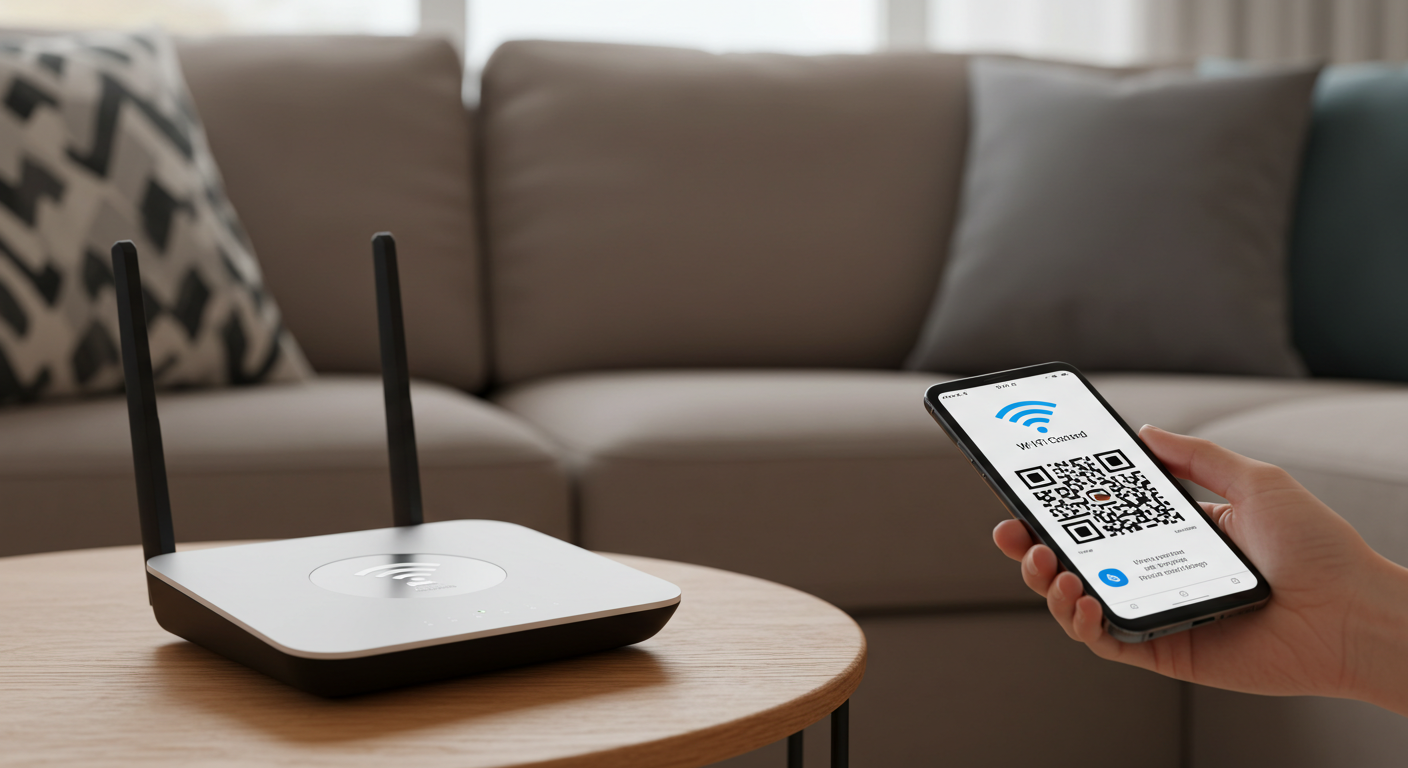How to Share Wi-Fi Credentials Securely with Guests

How to Share Wi-Fi Credentials Securely with Guests
Why “just text me the Wi-Fi” is a bad habit
Dropping your Wi-Fi password into group chats or printed signs creates long-term risk. Messages stick around, get forwarded, and end up in cloud backups. If you ever reuse that password elsewhere—or forget to change it—anyone with the old message can reconnect later.
Start with a safer network setup
- Use WPA2 or WPA3 Personal on all SSIDs. Avoid legacy or “open” networks.
- Create a Guest network (separate SSID) with its own password. Keep guests away from your private devices and shared folders.
- Block LAN access on the Guest SSID if your router supports it (isolate clients and deny local network discovery).
- Disable WPS (one-button pairing) to prevent easy abuse.
- Rotate the Guest password regularly (e.g., monthly or per event).
Three safe ways to share access (pick one)
- QR code card: Print a small QR code that encodes your Guest network. Guests scan and join—no password typing, less leakage.
- Time-boxed password: Set a temporary Guest password for the day and change it after the event.
- One-time note: Put the SSID + password in a single-view, self-destructing note with short expiry and share the link privately. See: The Safe Way to Share Passwords in 2025 (No Email).
Make a Wi-Fi QR code (no internet required)
Most camera apps can read a Wi-Fi QR. The plain-text format many readers understand looks like this (example—don’t reuse):
WIFI:T:WPA;S:GuestNetwork;P:SunnyDay-483!;H:false;;
- T: Security type (WPA or WPA2/WPA3 compatible).
- S: SSID (network name).
- P: Password (avoid personal info; use high-entropy).
- H: Hidden SSID (false for most setups).
Generate the QR offline if possible (router app, local tool, or a device that doesn’t upload data). Print and keep it at the door or kitchen counter; rotate it when you change the Guest password.
Step-by-step: the quick, safe workflow
- Step 1 — Create or enable a Guest SSID with WPA2/3 and client isolation.
- Step 2 — Set a strong, memorable-enough passphrase (or generate and store it in your manager). Learn how here: How to Create Strong Passphrases You’ll Actually Remember.
- Step 3 — Prepare a QR code and optionally a small card for guests.
- Step 4 — For private shares: put SSID + password in a single-view note with short expiry and send the link privately.
- Step 5 — After the visit or event: rotate the Guest password and, if printed, reprint the QR.
Do’s and Don’ts
- Do keep a separate Guest SSID; don’t give guests your main network password.
- Do rotate Guest credentials; don’t leave them unchanged for months.
- Do disable WPS; don’t rely on “hidden SSID” for security—it’s not effective.
- Do limit LAN access on Guest; don’t expose NAS, printers, or smart-home hubs.
- Do store the password in a manager; don’t paste it into family group chats.
Hosting a party or workshop? Use temporary credentials
For short events, set a temporary Guest password in advance, share it via a one-time note, and schedule a reminder to rotate it right after. If you run frequent events, some routers let you schedule automatic password changes on the Guest SSID.
Small-office tips
- Separate SSIDs: Staff vs. Guest.
- Per-device MFA and manager: Employees use a password manager and enable MFA on core services.
- Display a QR in the lobby for Guest Wi-Fi only; rotate weekly or monthly.
- Incident playbook: If a password leaks, revoke and rotate quickly. See: The Simple Incident Playbook for Leaked Passwords.
FAQ
Is a hidden SSID safer?
Not really. It only hides the name from casual scans; determined tools still see it. Use WPA2/3, strong passwords, and guest isolation instead.
Can guests still share the password?
Yes. That’s why Guest SSIDs and regular rotation matter. Treat every share as temporary.
What about device-to-device features like AirDrop or casting?
Keep those on your main network. Restrict or disable peer discovery on the Guest SSID.
Is a QR code risky?
It’s safer than posting the plaintext in chats. Keep QR codes private, rotate regularly, and avoid cloud QR generators for your home SSID.
Related reading
New to one-time sharing? Start here: The Safe Way to Share Passwords in 2025 (No Email)
Compare delivery methods: One-Time Links vs. Encrypted Email: What’s Safer in 2025?
Understand the model behind safer sharing: The Beginner’s Guide to Zero-Knowledge Sharing
Bottom line
Share access—without sharing your whole network. Use a Guest SSID, short-lived passwords, QR codes, and one-time notes. Rotate after every visit or event, and keep your main network off-limits.
Secure One-Time Messages - Send confidential messages that self-destruct after being read once. Your privacy is our priority. →.
🔒 Keep your home safe with ease: check out the Ring Rechargeable Quick Release Battery Pack 🔗 and never let your security camera run out of power.
🧠 Boost Your Brain Power Today
Curious about how far your brain can go? Neuro Surge is the new 2025 formula designed to enhance memory, focus, and mental clarity. Backed by science and optimized for performance, it's one of the top-rated brain supplements this year.
🔍 Learn More About Neuro Surge📜 Original Content Notice: This article was originally published on 🔒OneTimeRead. All rights reserved.
Reproducing or republishing this content without written permission is strictly prohibited. Our team combines historical research, ancient texts, and AI analysis to bring you unique insights into hidden history and mysterious knowledge from around the world.